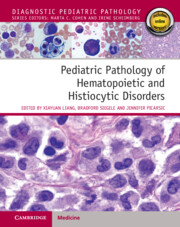Book contents
- Pediatric Pathology of Hematopoietic and Histiocytic Disorders
- Pediatric Pathology of Hematopoietic and Histiocytic Disorders
- Copyright page
- Epigraph
- Contents
- Contributors
- Section I General Hematology and Hematopathology
- Section II Non-Neoplastic Hematologic Disorders of Blood and Bone Marrow
- Section III Non-Neoplastic Disorders of Extramedullary Lymphoid Tissues
- Section IV Neoplastic Disorders of Bone Marrow
- Section V Mature Lymphoid Neoplasms
- Section VI Histiocytic Disorders and Neoplasms
- Chapter 24 Histiocytic Pathogenesis and Derivation
- Chapter 25 Identification of Macrophages and Dendritic Cells
- Chapter 26 Non-Neoplastic Accumulation of Histiocytes
- Chapter 27 Hemophagocytic Lymphohistiocytosis (HLH)
- Chapter 28 Histiocytic Inflammatory Neoplasms/Lesions
- Index
- References
Chapter 28 - Histiocytic Inflammatory Neoplasms/Lesions
from Section VI - Histiocytic Disorders and Neoplasms
Published online by Cambridge University Press: 25 January 2024
- Pediatric Pathology of Hematopoietic and Histiocytic Disorders
- Pediatric Pathology of Hematopoietic and Histiocytic Disorders
- Copyright page
- Epigraph
- Contents
- Contributors
- Section I General Hematology and Hematopathology
- Section II Non-Neoplastic Hematologic Disorders of Blood and Bone Marrow
- Section III Non-Neoplastic Disorders of Extramedullary Lymphoid Tissues
- Section IV Neoplastic Disorders of Bone Marrow
- Section V Mature Lymphoid Neoplasms
- Section VI Histiocytic Disorders and Neoplasms
- Chapter 24 Histiocytic Pathogenesis and Derivation
- Chapter 25 Identification of Macrophages and Dendritic Cells
- Chapter 26 Non-Neoplastic Accumulation of Histiocytes
- Chapter 27 Hemophagocytic Lymphohistiocytosis (HLH)
- Chapter 28 Histiocytic Inflammatory Neoplasms/Lesions
- Index
- References
Summary
Langerhans cell histiocytosis (LCH), juvenile xanthogranuloma (JXG), and Rosai-Dorfman-Destombes disease (RDD) can each manifest as a focal lesion, as multiple lesions, or as a widespread systemic disorder with organ involvement. Erdheim-Chester disease (ECD) is a rare systemic disease process in children, with more frequent adult presentations. New distinct emerging entities covered include ALK-positive histiocytosis and post-leukemia/lymphoma histiocytic lesions. These histiocytic lesions are now best classified as myeloid-derived inflammatory neoplastic disorders composed of clonal dendritic- or macrophage-/monocyte-derived cells that infiltrate tissues and are driven by recurrent kinase-activating alterations, most often in the mitogen-activated protein kinase (MAPK), PI3K-AKT, and receptor tyrosine kinase (RTK) signaling pathways, which have all had a long history of being associated with human neoplasia, with ERK overexpression noted in many of these neoplasms (Fig. 28.1; Table 28.1) (1–3). Furthermore, these oncological signaling cascades are critical to the intranuclear regulation of transcription factors that serve as key factors influencing cellular proliferation, survival, and differentiation (4).
- Type
- Chapter
- Information
- Pediatric Pathology of Hematopoietic and Histiocytic Disorders , pp. 330 - 351Publisher: Cambridge University PressPrint publication year: 2024

